To keep your home-pickled vegetables crisp, you'll need to start with ultra-fresh, firm produce at peak ripeness. Soak your veggies in ice water for 4-5 hours before pickling to preserve their natural pectin structure. Cut pieces uniformly and pack them tightly in clean jars. You can add grape leaves for natural tannins or use food-grade lime solution (followed by thorough rinsing) for extra crunchiness. Traditional firming agents like Pickle Crisp (calcium chloride) also help maintain texture. Proper processing temperatures and times are essential – too much heat will soften your pickles. Follow these foundational steps, and you'll reveal the secrets to perfectly crisp pickled vegetables.
Understanding Fresh Vegetable Selection

For successful home pickling, selecting the right vegetables is your foundation for success. You'll want to focus on vegetables that are at their peak of freshness, showing firm texture and vibrant colors. A sweet, earthy smell from your vegetables indicates they'll provide the best flavor for pickling. When you're choosing vegetables for pickling, avoid any with soft spots, blemishes, or signs of decay, as these imperfections will only worsen during the pickling process.
Look for vegetables that are crisp and heavy for their size. Your bell peppers should be firm with consistent coloring, while cucumbers need to be well-developed but not oversized. Root vegetables like carrots must be hard to the touch without any cracks. If you're including leafy vegetables, they should be free from browning edges or tears.
You'll get the best results by choosing seasonal vegetables, though greenhouse-grown options can work well year-round. Pay attention to specific characteristics for each vegetable type – broccoli should have compact, heavy heads with pale green coloring, while cauliflower needs to be firm and off-white.
Proper Vegetable Preparation Steps
You'll want to start with fresh, unblemished vegetables that are at their peak ripeness to guarantee the best pickling results.
For maximum crispness, soak your vegetables in an ice bath for 15-20 minutes before cutting them into uniform pieces.
When you're ready to cut, focus on maintaining consistent sizes – whether you're making spears, rounds, or slices – to guarantee even pickling throughout your batch.
Consider using green beans or asparagus as they naturally maintain their crunchy texture during the pickling process.
Fresh Selection Criteria
Selecting fresh vegetables for pickling requires careful attention to both quality and timing. You'll want to use vegetables that have just been picked, as each passing day diminishes their natural pectin and crispness. Once a vegetable becomes soft, there's no way to restore its firmness.
For the best results, choose top-quality vegetables that are naturally crisp and firm, such as carrots, cucumbers, and green beans. Pack them tightly in clean jars for optimal brining results. If you're making cucumber pickles, select ones that are no more than 2 inches in diameter and don't forget to remove the blossom end, which can harbor softening enzymes. Avoid any vegetables that show signs of damage or bruising.
You'll need to maintain the vegetables' structural integrity during preparation. Cut them into uniform pieces to guarantee even pickling, and handle them gently to prevent damage.
For denser vegetables like beets, you can either cook them until they're fork-tender or slice them very thinly. Remember to wash all vegetables thoroughly before packing them into jars.
To enhance flavor, you can add raw aromatics like garlic, ginger, and onion slices alongside your chosen vegetables.
Pre-Soak For Crispness
Achieving crisp, crunchy pickled vegetables starts with proper pre-soaking techniques. You've got several proven methods to choose from, each offering unique benefits for maintaining that desirable crunch. The simplest approach is ice water soaking, which firms up your vegetables by preserving their natural pectin structure during a 4-5 hour soak before pickling.
For more intensive crispness preservation, you'll find these effective pre-soaking options:
- Food-grade lime solution soaking for 12-24 hours, followed by thorough rinsing to remove excess lime
- Calcium chloride (Pickle Crisp) addition according to manufacturer's directions, which works with existing firmness
- Traditional grape leaf method, utilizing natural tannins to inhibit enzyme activity
- Ice water bath for 4-5 hours, particularly effective for cucumbers and similar vegetables
You'll want to choose your method based on time availability and desired results. If you're using calcium chloride, remember it preserves existing crispness but won't restore softened vegetables.
When working with lime solutions, don't skip the essential rinsing step, as excess lime can affect your pickle's safety and acidity levels. Each technique targets the vegetable's pectin structure, helping to maintain that satisfying crunch you're after.
Uniform Cutting Methods
After ensuring your vegetables maintain ideal crispness through pre-soaking, proper cutting techniques become the next important step in the pickling process.
You'll need to cut your vegetables into uniform pieces to achieve consistent flavor and crunch throughout your batch. Start by selecting fresh, high-quality vegetables and handle them gently to prevent damage.
When working with cucumbers, you've got several cutting options depending on your preferred pickle style. Cut them into spears by quartering lengthwise, slice them into ¼-inch rounds, or halve them lengthwise.
Don't forget to remove the blossom end, as it contains enzymes that can cause softening. For other vegetables, you can use a mandoline or crinkle cutter to create consistent slices and strips.
Keep your cuts uniform by ensuring all pieces are similar in size – this helps with both brine penetration and visual appeal. If you're working with larger vegetables, cut them into smaller, matching chunks.
Remember to clean and trim any uneven edges before making your final cuts. These precise cutting methods will help you achieve professional-looking pickles with consistent texture and taste.
Essential Equipment and Tools
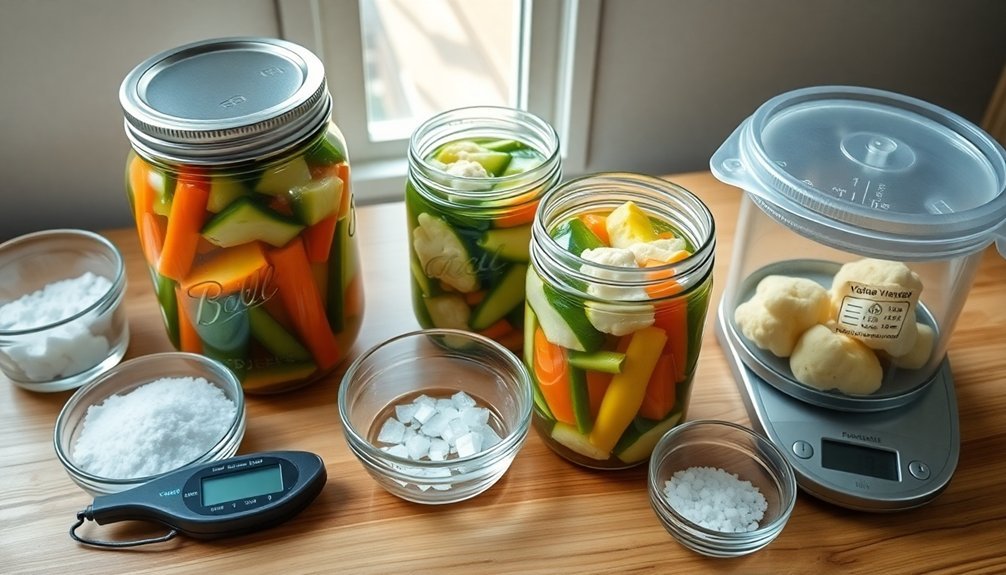
Proper equipment serves as the foundation for successful home pickling, and you'll need several essential tools to get started. You'll want to gather clean, wide-mouth mason jars free from cracks and chips, ensuring they're hot when you're ready to pack your vegetables.
Sanitizing your equipment is vital – while regular dish soap works well, you might prefer specialized sanitizers like Star San to eliminate unwanted bacteria and yeast.
To keep your vegetables properly submerged and fermented, you'll need:
- Fermentation weights or water-filled resealable bags to hold vegetables under brine
- Air locks and compatible lids to release gases while keeping outside air out
- A sharp knife or mandoline (with cut-resistant glove) for uniform slicing
- A wide-mouth funnel to prevent spills when filling jars
- A jar lifter and bubble freer for safe handling and air removal
Don't forget to create a sanitized workspace before you begin.
Each piece of equipment plays a specific role in ensuring your pickled vegetables maintain their quality throughout the fermentation process. Remember to check that all your tools are clean and readily accessible before starting your pickling project.
Perfect Brine Recipe
Behind every successful batch of pickled vegetables lies a perfectly balanced brine. You'll need to maintain a strict 1:1 ratio of vinegar to water to guarantee both safety and ideal flavor. For each cup of this liquid combination, add 1-2 teaspoons of salt and, if desired, a tablespoon of sugar.
To create your brine, combine your chosen vinegar (whether it's distilled white or apple cider), water, salt, and sugar in a pot. You can enhance the flavor by adding whole spices like peppercorns, mustard seeds, or coriander.
Bring the mixture to a boil, letting the heat dissolve the salt and sugar while releasing the essential oils from your spices.
Before using the brine, you'll want to taste it to guarantee the flavors are balanced. Remember, you can't exceed the amount of water compared to vinegar, as this will compromise the brine's safety.
When you're ready to use it, let the hot brine cool slightly before pouring it over your prepared vegetables. Always leave about 1/2 inch of headspace at the top of your jars for proper preservation.
Safe Pasteurization Methods
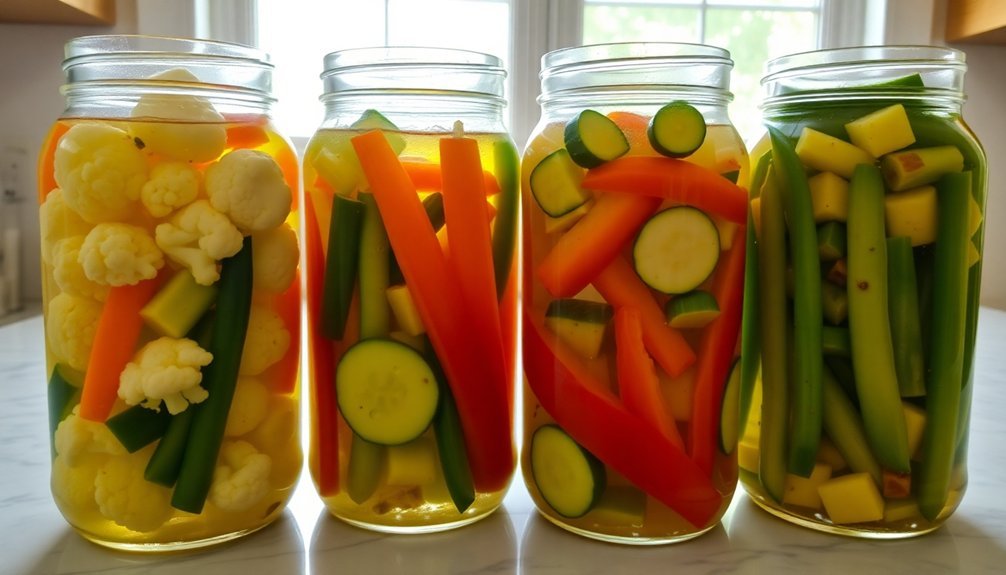
Successfully pasteurizing your pickled vegetables requires choosing between two proven methods: the traditional boiling water bath or the gentler low-temperature approach.
If you're using the boiling water bath method, you'll need to process your jars at sea level for specific times, adjusting for altitude. For the low-temperature method, maintain water at 180-185°F for 30 minutes to preserve texture better.
Whichever method you choose, proper preparation is important. You'll want to:
- Pack your vegetables into sterilized jars with 1/2-inch headspace
- Remove air bubbles using a flat plastic spatula
- Clean jar rims with a damp paper towel
- Use fresh ingredients and proper pickling salt
- Verify your vinegar has 5% acidity
The low-temperature method doesn't require altitude adjustments, making it simpler, but you'll need precise temperature control.
If you're using the boiling water bath, remember to increase processing time with elevation: 5 minutes for pints at 0-1,000 ft, 10 minutes at 1,001-6,000 ft, and 15 minutes above 6,000 ft.
Don't skip the essential step of checking acidity levels – it's critical for preventing bacteria growth and confirming your pickles are safe to eat.
Natural Firming Techniques
After ensuring your pickles are safely pasteurized, you'll want to focus on achieving that satisfying crunch. Start by selecting the freshest vegetables possible, particularly cucumbers that are no more than 2 inches in diameter. Don't forget to remove the blossom end, as it contains enzymes that can soften your pickles.
You can employ several soaking methods to enhance crispness. Soak your vegetables in ice water for 4-5 hours before pickling, or use a saltwater solution for at least 3 hours. For extra firmness, try a lime-water solution for 12-24 hours, but remember to rinse thoroughly afterward to remove excess lime.
If you're looking for additional firming agents, you've got options. Add up to 1/4 teaspoon of alum per pint for fermented pickles, or use Ball Calcium Chloride Pickle Crisp according to package directions.
While grape leaves were traditionally used for their tannins that help maintain pectin structure, they're not necessary if you've removed the cucumber's blossom end.
Whatever method you choose, maintain proper acidity levels to support the natural firming process of your vegetables.
Storage and Shelf Life
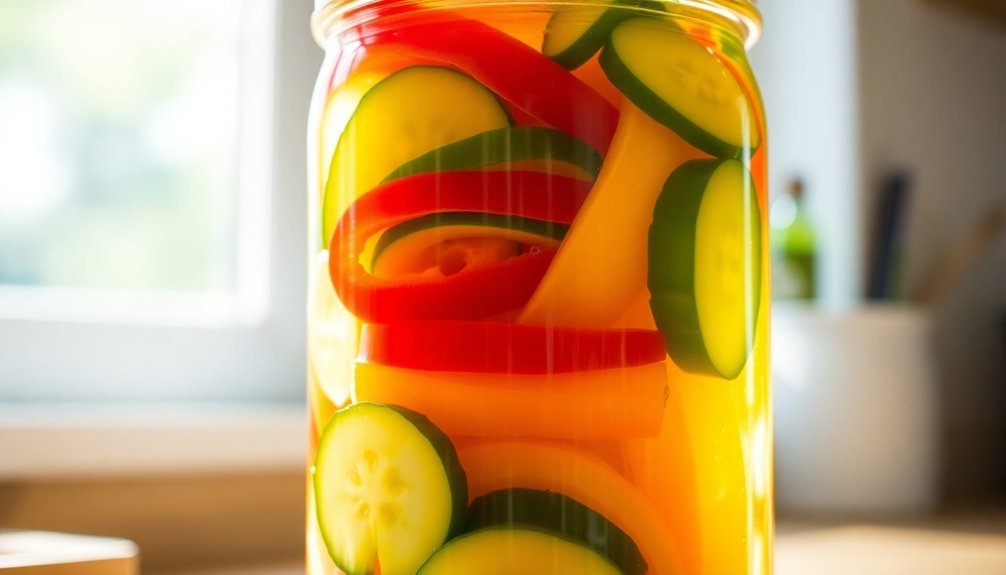
Keep your pickled vegetables in peak condition by storing them at consistent temperatures between 35-45°F in your refrigerator once opened, or in a cool pantry at 50-70°F for unopened jars.
You'll want to check the jar seals monthly by pressing down on the center of the lid to verify it hasn't popped up, which could indicate a compromised seal.
To maintain the best quality, always wipe jar rims clean before securing the lids and verify the pickling liquid completely covers the vegetables.
Proper Storage Temperature Control
Maintaining proper storage temperature plays an essential role in preserving your home-pickled vegetables' quality and safety. You'll need to keep your pickles at consistently cool temperatures, with your refrigerator set below 40°F to prevent harmful bacteria growth and maintain ideal crispness.
If you've properly canned your pickles, you can store them in a cool, dark, dry place, but once opened, they must go straight to the fridge.
During the canning process, use lower pasteurization temperatures (180-185°F) to help preserve the vegetables' crispness. After that, you'll want to protect your pickles from temperature fluctuations and heat exposure that can break down their pectin structure and lead to softening.
Here are key temperature control practices to follow:
- Keep jars away from direct sunlight and heat sources
- Monitor your refrigerator's temperature regularly to verify it stays below 40°F
- Store unopened, properly sealed jars in a cool basement or pantry
- Consider reinforcing refrigerator shelves to support heavy pickle jars
- Check fermented pickles daily during the initial fermentation period to verify proper temperature conditions
Jar Seal Maintenance Tips
The success of your home-pickled vegetables largely depends on proper jar sealing and maintenance techniques. To guarantee your pickles stay fresh and safe, you'll need to verify the seal within 12 to 24 hours after processing. Press the center of each lid – it should be concave and shouldn't flex when pressed. You can also lift the jar by the lid; if it stays firmly attached, you've got a proper seal.
For long-term storage, remove the screw bands after the jars have completely cooled and been cleaned. Keep your sealed pickles in a cool, dry place where the temperature stays between 50°F and 70°F. When stored properly, your pickles will maintain their quality for 1 to 2 years.
If you notice any jars that didn't seal properly, you can reprocess them within 24 hours using new lids and the original processing time.
Once you've opened a jar, refrigerate the pickles and plan to use them within 1 to 3 months for the best quality. Always check for signs of spoilage before consuming, including bulging lids, unusual odors, or any visible mold growth.
Common Pickling Problems
Successful pickling requires attention to detail, as several common issues can affect your final product. Understanding these challenges will help you maintain crisp, flavorful pickles that you'll enjoy throughout the year.
Soft or slippery pickles often result from using weak vinegar or insufficient brine, while shriveled pickles typically occur when you've used too strong a solution or overprocessed your vegetables. To avoid hollow pickles, you'll need to process your vegetables quickly after harvesting and guarantee proper brine strength during fermentation.
To maintain ideal crispness in your pickled vegetables, follow these essential practices:
- Start with fresh, just-picked vegetables within 24 hours of harvesting
- Remove blossom ends completely, cutting at least 1/16th inch off
- Use proper low-temperature pasteurization (180-185°F for 30 minutes)
- Add food-grade lime or calcium chloride to support pectin structure
- Soak cucumbers in ice water for 4-5 hours before pickling
You can prevent most pickling problems by using fresh ingredients, following tested recipes exactly, and maintaining proper processing temperatures.
Remember that larger vegetables are more prone to shriveling, so choose smaller, firm specimens for whole pickles.
Frequently Asked Questions
Can Pickled Vegetables Be Re-Crisped After They've Become Soft?
You can't re-crisp pickled vegetables once they've become soft. The softening process is irreversible because it permanently changes the vegetable's cellular structure. Focus on preventing softening through proper pickling techniques instead.
Does the Size of Vegetable Pieces Affect Their Final Crispness?
While you'll find that vegetable size doesn't dramatically impact final crispness, you should cut pieces uniformly to guarantee even brine exposure. What's more important is using fresh produce and proper pickling techniques.
Will Adding Extra Vinegar Make Pickled Vegetables Crispier?
No, adding extra vinegar won't make your vegetables crispier. In fact, using too much vinegar can cause them to shrivel. You'll get better results by sticking to the recipe's recommended vinegar-to-water ratio.
Can Homemade Pickles Be as Crisp as Store-Bought Ones?
Yes, you'll get pickles as crisp as store-bought ones if you use fresh pickling cucumbers, remove blossom ends, add proper firming agents, and follow tested recipes. Careful handling and timing are essential.
Do Different Types of Salt Affect the Crispness of Pickled Vegetables?
Yes, your salt choice matters! You'll get the best crispness using pickling or canning salt, while mineral-rich salts work well too. Don't use table salt – its additives can make your brine cloudy and affect texture.
In Summary
Keep your pickled vegetables crisp by starting with fresh, high-quality produce and using natural firming agents like grape leaves, alum, or calcium chloride. You'll get the best results when you trim ends properly, avoid overcooking, and maintain proper brine concentration. Don't skip the ice bath step before processing, and always store your jars in a cool, dark place. With these techniques, you'll enjoy crunchy pickled vegetables for months.

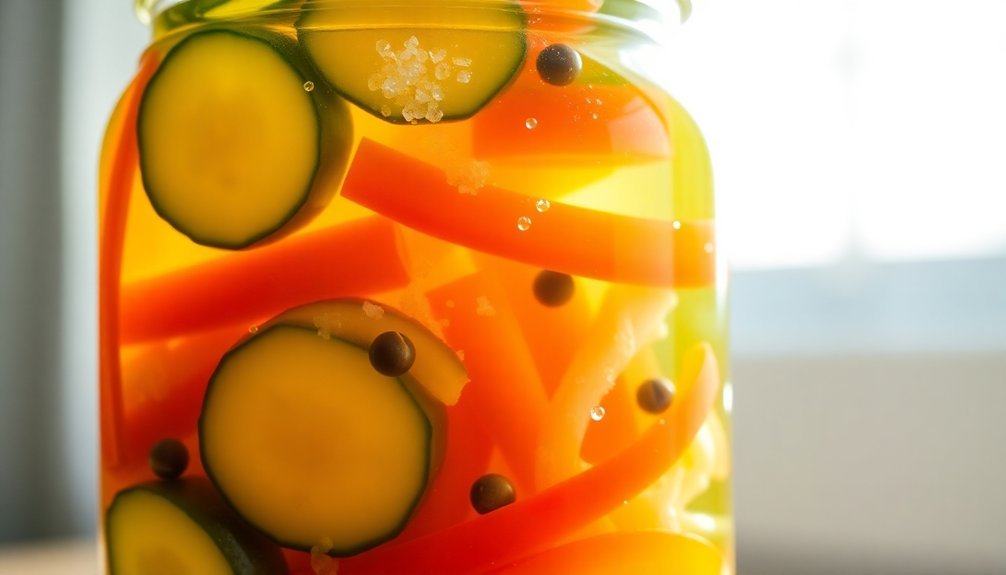
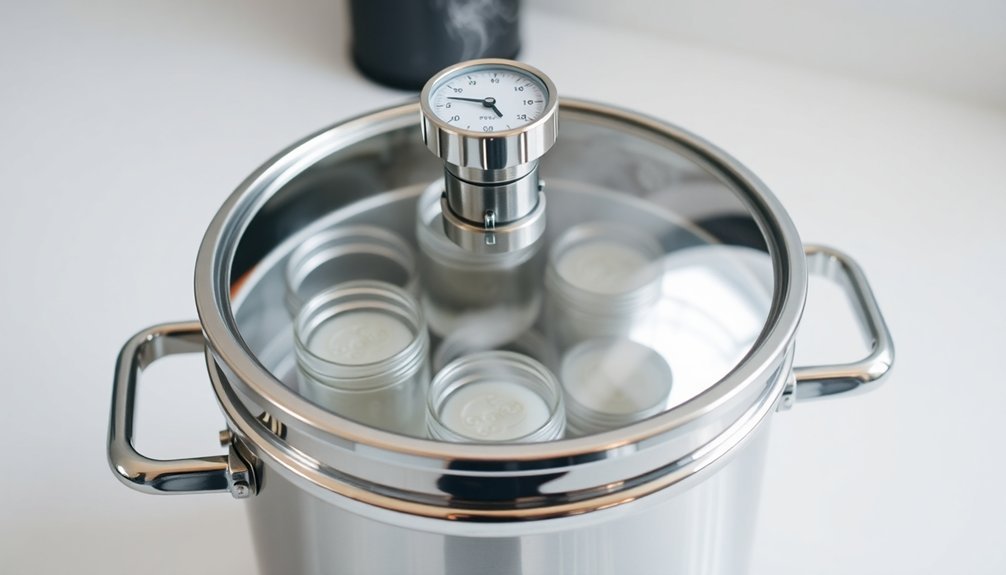
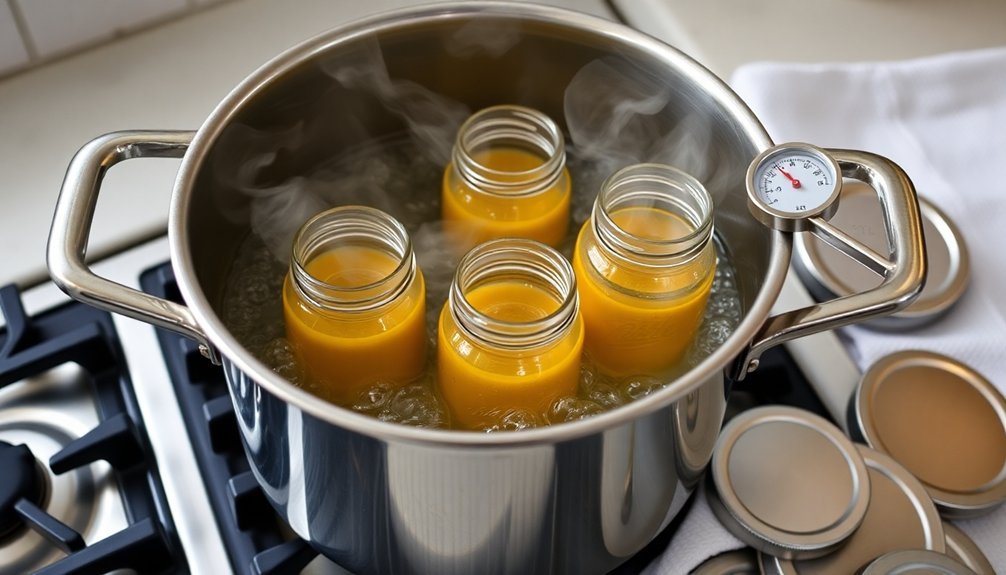
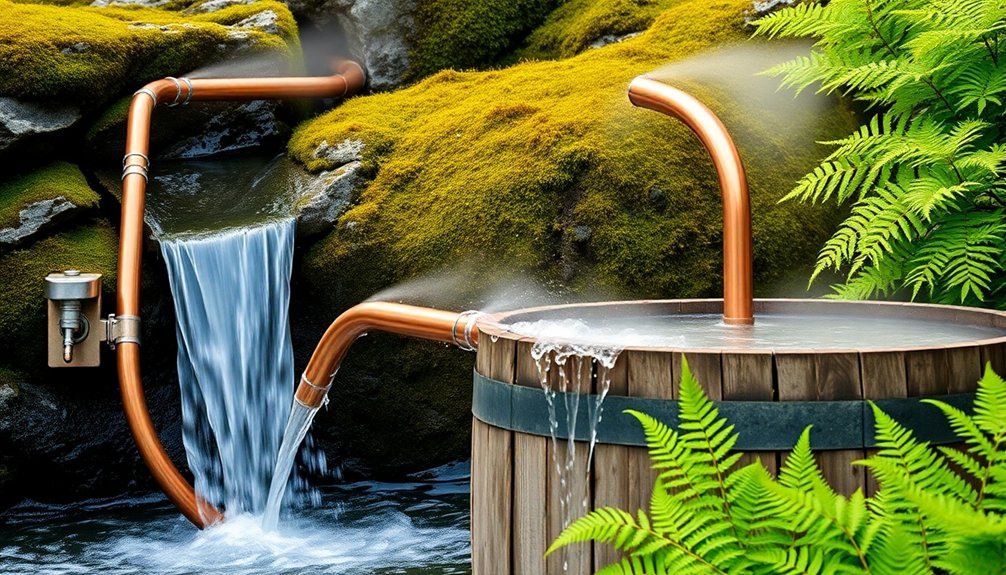
Leave a Reply